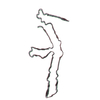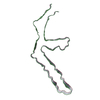+Search query
-Structure paper
| Title | Novel tau filament folds in individuals with mutations P301L and P301T. |
|---|---|
| Journal, issue, pages | bioRxiv, Year 2024 |
| Publish date | Aug 17, 2024 |
 Authors Authors | Manuel Schweighauser / Yang Shi / Alexey G Murzin / Holly J Garringer / Ruben Vidal / Jill R Murrell / M Elena Erro / Harro Seelaar / Isidro Ferrer / John C van Swieten / Bernardino Ghetti / Sjors H W Scheres / Michel Goedert /      |
| PubMed Abstract | Mutations in , the microtubule-associated protein tau gene, give rise to cases of frontotemporal dementia and parkinsonism linked to chromosome 17 (FTDP-17) with abundant filamentous tau inclusions ...Mutations in , the microtubule-associated protein tau gene, give rise to cases of frontotemporal dementia and parkinsonism linked to chromosome 17 (FTDP-17) with abundant filamentous tau inclusions in brain cells. Individuals with pathological variants exhibit behavioural changes, cognitive impairment and signs of parkinsonism. Missense mutations of residue P301, which are the most common mutations associated with FTDP-17, give rise to the assembly of mutant four-repeat tau into filamentous inclusions, in the absence of extracellular deposits. Here we report the cryo-EM structures of tau filaments from five individuals belonging to three unrelated families with mutation P301L and from one individual belonging to a family with mutation P301T. A novel three-lobed tau fold resembling the two-layered tau fold of Pick's disease was present in all cases with the P301L tau mutation. Two different tau folds were found in the case with mutation P301T, the less abundant of which was a variant of the three-lobed fold. The major P301T tau fold was V-shaped, with partial similarity to the four-layered tau folds of corticobasal degeneration and argyrophilic grain disease. These findings suggest that FTDP-17 with mutations in P301 should be considered distinct inherited tauopathies and that model systems with these mutations should be used with caution in the study of sporadic tauopathies. |
 External links External links |  bioRxiv / bioRxiv /  PubMed:39185206 / PubMed:39185206 /  PubMed Central PubMed Central |
| Methods | EM (helical sym.) |
| Resolution | 2.26 - 3.36 Å |
| Structure data | EMDB-51319, PDB-9gg0: EMDB-51320, PDB-9gg1: EMDB-51325, PDB-9gg6: |
| Source |
|
 Keywords Keywords | PROTEIN FIBRIL / P301L tau / Frontotemporal dementia and parkinsonism linked to chromosome 17 / Electron cryo-microscopy / P301T tau |
 Movie
Movie Controller
Controller Structure viewers
Structure viewers About Yorodumi Papers
About Yorodumi Papers









 homo sapiens (human)
homo sapiens (human)